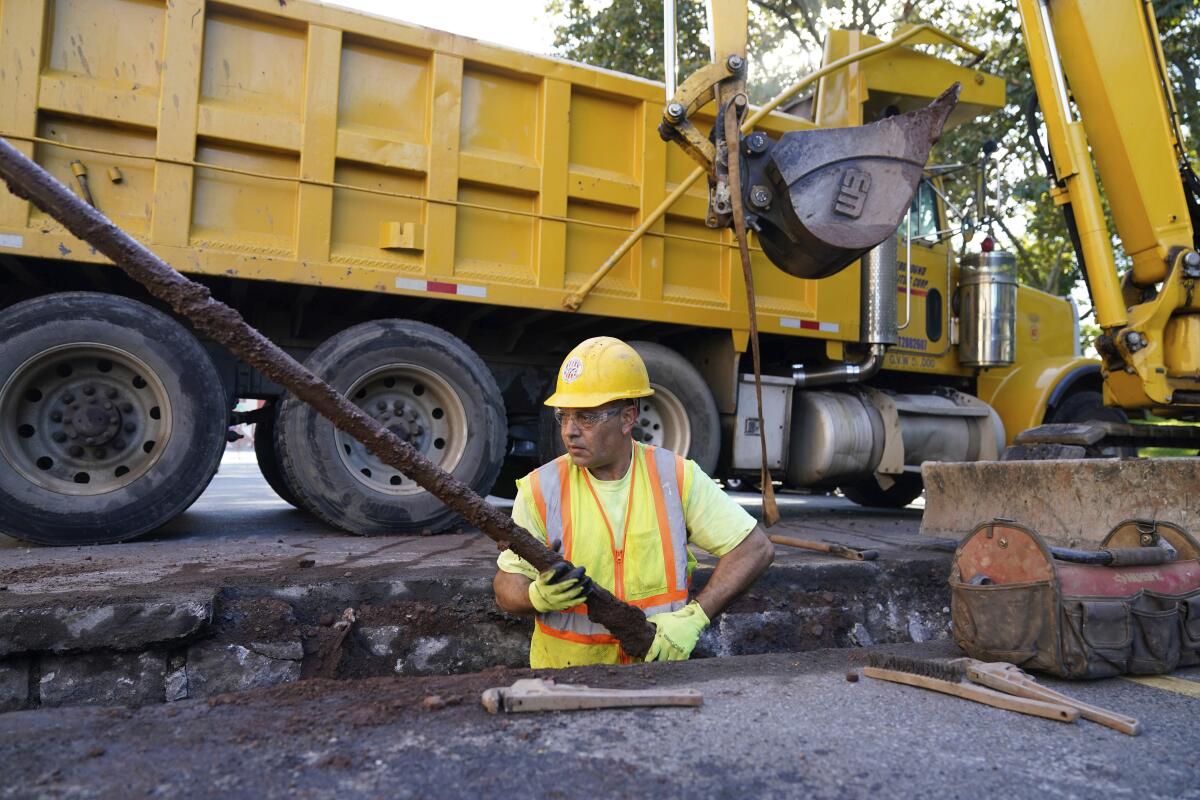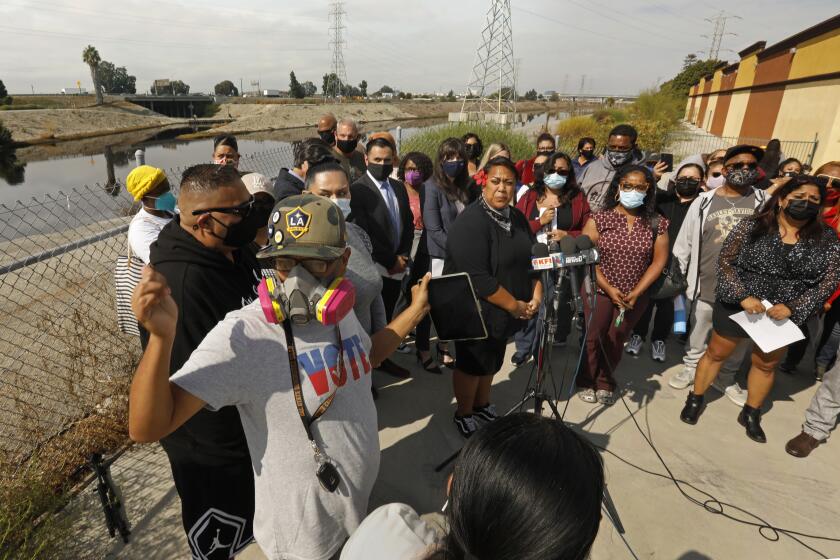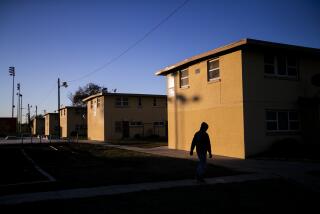After drinking water crisis, Newark is winning war on lead

- Share via
NEWARK, N.J. — On a recent sun-drenched morning, the staccato rhythms of a jackhammer ricocheted off buildings as a work crew dug into a Newark street to remove an aging pipe that carried water — and potentially a poison — to a small apartment building.
The new pipe is copper. The old one was lined with lead, which can be harmful to human health even at minute levels.
The water service line was one of more than 20,000 made with the toxic metal the city began replacing in 2019 amid public outrage over revelations about high lead levels in the tap water in schools and homes across the city.
Less than three years after the work began, the replacement project, initially projected to take up to 10 years, is nearly complete.
City residents who switched to bottled water during the crisis are breathing — and drinking — easier. Newark, once castigated and sued over its sluggish response to the problem, is being held up as a potential national model.
“I’m just happy that it’s happening and that it’s finally getting taken care of so we finally get to drink tap water again,” Newark resident Cesar Velarde said as he watched the crew work. “I have three cases of bottled water right now. I don’t drink faucet water no more because of this.”
More than a month into a siege of rotten-egg odors, Carson and surrounding areas have no definitive answers. Residents deserve a better response.
The pipe replacement project has been a vindication of sorts for Mayor Ras Baraka, who faced mounting public pressure in 2018 after the Natural Resources Defense Council, a nonprofit environmental advocacy group, sued, claiming New Jersey’s largest city had failed to adequately monitor lead levels and had downplayed the problem to residents.
Deteriorating lead-lined pipes, some a century old, are a problem in many older U.S. cities, a recent example being Benton Harbor, Mich. But Newark’s replacement project proceeded faster than expected, thanks to an infusion of state and local funds and an amendment to state law to protect homeowners from having to bear the cost.
“I’ll feel better when we’re completely finished, but I’m excited that we’re at the end of this thing. It’ll be a huge milestone for us,” Baraka said last week.
Newark’s efforts led to the lawsuit being settled last January, and drew praise from the Natural Resources Defense Council.
“It’s a pretty significant turnaround from the early days when the city was denying they had a lead problem,” Erik Olson, NRDC senior strategic director for health, said. “We are pointing to it as a model for other cities to follow. They’re doing it much faster than other cities have even tried to do.”
The NRDC estimated recently that there are as many as 12 million lead service lines in the U.S. Nearly half of all states don’t even track the number of lead lines within their borders, the group found.
Lead in drinking water has been linked to developmental delays in children and can damage the brain, red blood cells and kidneys.
The challenge of removing lead from drinking water in the U.S. came into sharp focus after the Flint, Mich., scandal in which city leaders switched water sources in 2014 to save money. That led to criminal charges, though many later were dropped, and a $641-million settlement for the residents of the poor, majority Black city.
The $1-trillion infrastructure plan passed by the House on Friday night and now awaiting President Biden’s signature includes $15 billion to replace lead pipes.
Several hundred lead lines remain to be replaced in Newark, many connected to buildings that were not accessible earlier in the project.
The process can take up to five hours, though many replacements take less time because they involve smaller pipes that can be pulled out and replaced by making a smaller cut in the curbside, said Mark Wleklik, foreperson for Underground Utilities, a company that has done thousands of pipe replacements in Newark.
More than 70% of Newark residents are renters, and many of the buildings are owned by limited-liability corporations based elsewhere that can be hard to track down, said Kareem Adeem, director of the city’s water and sewer department.
“It’s hard to chase an LLC down to Texas or Missouri or Louisiana or California,” Adeem said. “The renters always want the line to be replaced, but they don’t own the property.”
That led the Newark City Council to pass an ordinance allowing tenants to provide access to buildings. An amendment to a state law paved the way for public money to be used for the replacements — which can cost thousands of dollars per home — and Newark was able to borrow $120 million. All those efforts allowed the city of more than 310,000 people to accelerate its line replacements to as many as 120 per day.
The city also created a program that trained about 75 unemployed and underemployed residents to work on the line replacement crews, Adeem said.
Looking back, Baraka described the confrontation with the Natural Resources Defense Council as “tough, tense, with no love lost,” but he admitted learning some lessons.
“We were so busy trying to fight the NRDC, we were having conversations with them and not with the residents,” he said. “We thought they were wrong and wanted to oversee the city, and we already had oversight. So we were trying to fight that as opposed to being on the offensive and saying, ‘We have this problem, let’s go out and fix this.’”
For some, praise for the Newark’s accomplishment needs to be taken in context. Yvette Jordan, a teacher and chairperson of the Newark Education Workers Caucus, which joined the lawsuit brought by the resources council, said it was no coincidence that many of the city’s actions came at a time when Baraka was seeking reelection and Newark was in the running to become home to Amazon’s second headquarters.
“This showed us that the community must rise up and say something,” said Jordan, whose own home showed high levels of lead in its drinking water at one point.
“Without the community screaming and yelling and saying, ‘We need this,’ nothing is going to happen. The state and federal government also have to say, ‘We’re going to do this’ and have the political will to do it. Without that political will, without the stars aligning, I don’t think you would see Newark as this national model.”
More to Read
Sign up for Essential California
The most important California stories and recommendations in your inbox every morning.
You may occasionally receive promotional content from the Los Angeles Times.











